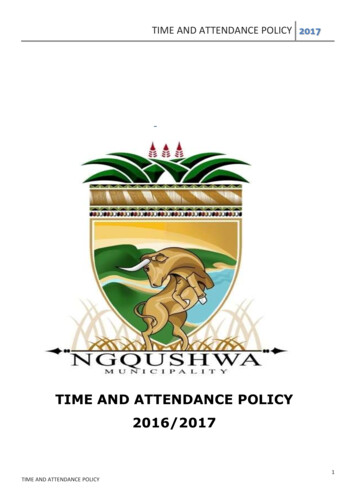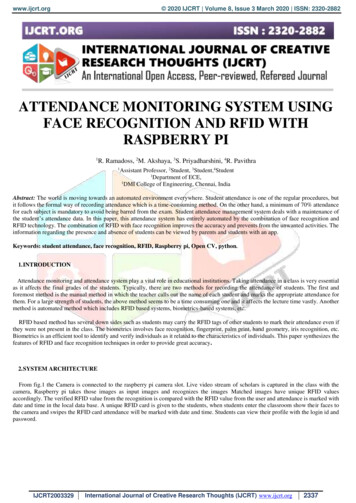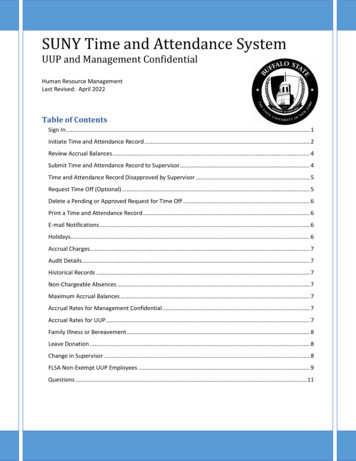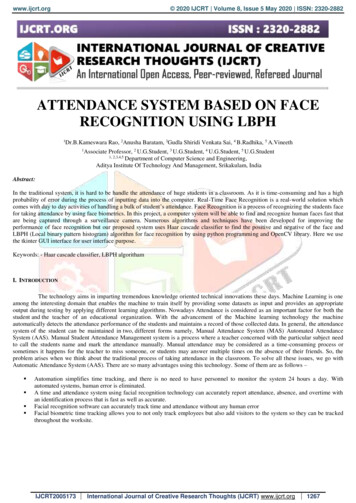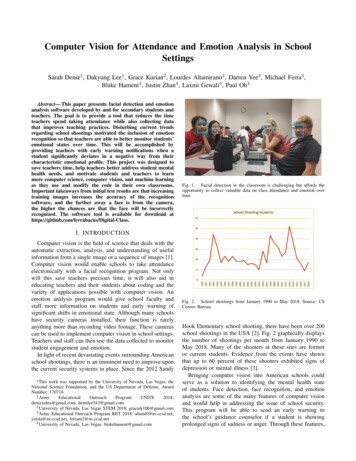
Transcription
Computer Vision for Attendance and Emotion Analysis in SchoolSettingsSarah Deniz1 , Dakyung Lee1 , Grace Kurian2 , Lourdes Altamirano3 , Darren Yee3 , Michael Ferra3 ,Blake Hament4 , Justin Zhan4 , Laxmi Gewali4 , Paul Oh4Abstract— This paper presents facial detection and emotionanalysis software developed by and for secondary students andteachers. The goal is to provide a tool that reduces the timeteachers spend taking attendance while also collecting datathat improves teaching practices. Disturbing current trendsregarding school shootings motivated the inclusion of emotionrecognition so that teachers are able to better monitor students’emotional states over time. This will be accomplished byproviding teachers with early warning notifications when astudent significantly deviates in a negative way from theircharacteristic emotional profile. This project was designed tosave teachers time, help teachers better address student mentalhealth needs, and motivate students and teachers to learnmore computer science, computer vision, and machine learningas they use and modify the code in their own classrooms.Important takeaways from initial test results are that increasingtraining images increases the accuracy of the recognitionsoftware, and the farther away a face is from the camera,the higher the chances are that the face will be incorrectlyrecognized. The software tool is available for download athttps://github.com/ferrabacus/Digital-Class.Fig. 1. Facial detection in the classroom is challenging but affords theopportunity to collect valuable data on class attendance and emotion overtime.I. INTRODUCTIONComputer vision is the field of science that deals with theautomatic extraction, analysis, and understanding of usefulinformation from a single image or a sequence of images [1].Computer vision would enable schools to take attendanceelectronically with a facial recognition program. Not onlywill this save teachers precious time, it will also aid ineducating teachers and their students about coding and thevariety of applications possible with computer vision. Anemotion analysis program would give school faculty andstaff more information on students and early warning ofsignificant shifts in emotional state. Although many schoolshave security cameras installed, their function is rarelyanything more than recording video footage. These camerascan be used to implement computer vision in school settings.Teachers and staff can then use the data collected to monitorstudent engagement and emotion.In light of recent devastating events surrounding Americanschool shootings, there is an imminent need to improve uponthe current security systems in place. Since the 2012 Sandy*This work was supported by the University of Nevada, Las Vegas, theNational Science Foundation, and the US Department of Defense. AwardNumber: 1707161 @gmail.com, demilee543@gmail.com2 University of Nevada, Las Vegas STEM 2018: graciek106@gmail.com3 Army Educational Outreach Program RET 2018: altamlf@nv.ccsd.net,yeeda@nv.ccsd.net, ferram2@nv.ccsd.net4 University of Nevada, Las Vegas: blakehament@gmail.comFig. 2. School shootings from January 1990 to May 2018. Source: USCensus Bureau.Hook Elementary school shooting, there have been over 200school shootings in the USA [2]. Fig. 2 graphically displaysthe number of shootings per month from January 1990 toMay 2018. Many of the shooters at these sites are formeror current students. Evidence from the events have shownthat up to 60 percent of these shooters exhibited signs ofdepression or mental illness [3].Bringing computer vision into American schools couldserve as a solution to identifying the mental health stateof students. Face detection, face recognition, and emotionanalysis are some of the many features of computer visionand would help in addressing the issue of school security.This program will be able to send an early warning tothe school’s guidance counselor if a student is showingprolonged signs of sadness or anger. Through these features,
teachers may utilize face recognition to save time spent oncurrent attendance methods and familiarize themselves andtheir students with computer vision and computer learningsoftware. With this software providing motivation and alaunching point, teachers can build curriculum and investigatory projects for students on Computer Vision and MachineLearning. Facial recognition and emotion analysis can helpteachers monitor the changes in their student behaviors toincrease productivity and student achievement.A. Educational ToolNot only can this program be applied to the school’ssecurity system, it can also be used to expand students’ andteachers’ knowledge about coding. The interactive Scratchwebsite that was created by MIT is a tool schools use toteach their students the basics of programming [4]. Similarly, this program can help educate students about facedetection, recognition, and emotion analysis by providinga launching point for project-based learning. This programincorporates computer vision and machine learning, andstudents can explore other possible applications of thesetopics. Many schools already have computer science classes,and students can learn how this program works as theylearn to code. Seeing a real-life application of code caninspire students to make their own modifications and versionsof the project. School attendance and security are relevanttopics for students, and the authors hope students willbe motivated to further develop and customize the codeas an open-source community. The code is available athttps://github.com/ferrabacus/Digital-Class.B. Literature ReviewPython was selected as the primary software language forthis projects as it is very human-readable and accessibleto beginner and intermediate coders. The most importantdependency for this program is Open Source ComputerVision Library (OpenCV) which is commonly utilized forfacial recognition purposes [5]-[9]. OpenCV was used to implement proven facial detection and recognition methods likeHaar features and Local Binary Pattern Histogram (LBPH)classification. Haar features are digital image features used inobject recognition and face detection. First, the image takenfrom the video feed is made grayscale. Then, the programscans the face to compare the shadows and highlights on theimage to the Haar features. Haar features are vital for theprogram to detect faces and an essential step in this facialrecognition pipeline [10]-[11]. LBPH is a method used forfacial recognition, along with EigenFaces and FisherFaces.LBPH is well-adapted for feature extraction because it examines the texture and structure of an image in small, localneighborhoods of pixels. The main focus of LBPH is on thedetails rather than the big picture, defining image featuresin relative terms that make the algorithm less sensitive tochanges in lighting in training and test images [12]-[14].This makes the program’s ability to recognize a person morerobust in varying lighting conditions.Finally, in order to analyze student emotion, MicrosoftAzure Face was used. Microsoft Azure is a growing collection of cloud services for building, deploying, and managingintelligent applications through a global network of datacenters [15]. Although it has many different fields and applications, this project only utilized the emotion analysis featureof the FACE application programming interface (API). Itis this team’s hope that this software tool will be furtherdeveloped to include proprietary ML algorithms for emotionrecognition that will eventually replace the Azure Face APIquery. In the meantime, the Azure Face API accomplishesour emotion analysis.In order to keep the code accessible to high school teachersand students who may be beginner or intermediate coders,the program balances the trade-off between implementingstate-of-the-art algorithms and maintaining a software architecture that is friendly to users of all levels of codingexperience. The OpenCV library was used because it offersmany beginner-friendly tools and ways to incorporate provencomputer vision algorithms. In future stages of development,more low-level control over classifiers and other machinelearning algorithms used in facial detection and recognitionwill be introduced. OpenCV allows for students to get startedusing stock machine learning algorithms right away, whilealso introducing them to enough of the image processingand program architecture that they will be able to transitionto lower-level control of the algorithms later on. This willbe accomplished with the incorporation of popular machinelearning libraries like TensorFlow and Keras.II. METHODOLOGYIn order to properly be able to execute the project, wewill need the code for face detection, face recognition andemotion analysis, as well as a computer to run the programon. This program has been successfully tested on an HP Envyx360 with Windows x64 i7 with 8GB memory as well as aMacBook Pro with iOS High Sierra i7 with 16GB memory.Python is the primary coding language, Microsoft VisualStudio Code and Atom Editor were used as the integrateddevelopment environments (IDEs).A. Code OverviewThe first step in the program is to receive either videofootage or an image from the user. If a video is received,the program separates the video into individual frames tobe processed as images. Afterwards, the program uses Haarfeatures to detect the faces in the photo by cascading. Rectangular coordinates are specified around the corners of the facedetected in the image. A rectangle is drawn around any facesthat are detected. Next, the program cross-references the facein the image with all the faces in the training set. If thereis a match, then the corresponding name will be displayedabove of the rectangle drawn previously. If the confidenceis greater than 200, and no suitable match is found, themessage “ERROR: UNKNOWN FACE” is displayed on topof the rectangle in place of a name. Fig. 3. shows howthe program displays the matched person’s name with the
Fig. 3. After face detection, facial recognition is performed using LBPHclassification, and an error score is computed.Fig. 4.Emotion analysis outputs probability distribution for 8 emotions.confidence score next to it. Though the official OpenCV termfor this value is confidence score, it is misleading becausea lower score implies higher accuracy. The confidence scoreis calculated by taking the difference or root mean squareddistance between the classification model and an observedfeature. Thus, if it is a close match, the score will be low,but if they deviate significantly, the score will be high. Thispaper interchangeably refers to the confidence score as anerror score.Once the face is matched to a name, the data collectionprocess is initiated. If the program sees that person’s face,it marks them as “Present.” Otherwise, it will mark them as“Absent.” Furthermore, the program saves the data about theperson’s overall emotions in the image. There are eight emotions the program can recognize: anger, contempt, disgust,fear, happiness, neutral, sadness, and surprise. Although alleight emotions are recognized, the program will only trackthe data for happiness, sadness, anger, and neutrality. Fig. 3shows a sample image and Fig. 4 displays the output afterthe program has analyzed the emotions of the face shown inFig. 3. After the data has been recorded in a CSV file, theprogram finds the average, and then the program will sendthe data via email to the addresses provided.Notifications will be sent via email weekly to teachers andparents regarding the students’ presence and emotional state.Another notification will be sent to the school’s guidancecounselor if the student is especially sad or mad for morethan 4 consecutive days. Algorithm 1 is the pseudo code forthe criteria for the notifications to be sent to the guidanceFig. 5. A visual representation of the program modules with input andoutput at each level.counselor as well as the averaging. Below is the standardequation for averaging data used for emotion analysis andprofiles.Algorithm 1 Algorithm for Guidance Counselor Notification:Input: Array of 8 Emotion AveragesOutput: Guidance Counselor NotificationCalculate 8 emotion averages and store in emoAvgsi 0for avg in emoAvgs doif (avg threshold and (i indexanger or i indexsad )) thensend notification to Guidance Counselorend ifi end forreturnA 1/n (x1 x2 x3 . xn )(1)Fig. 5 displays a flowchart that explains the modules andmethods of the program, as well as the input and output toeach of module.B. TestingThe changes in the error/confidence score were measuredto test how different variables affect the program’s successrate. This score is a measurement of how closely an image
TABLE I8 percent happy.E RROR S CORE AND T RAINING DATA - SET S IZENumber ofTraining ImagesAvg Score ForCorrect Face RecognitionAvg Score ForIncorrect Face Recognition2077.571.2518040.043.0TABLE IIE RROR S CORE AND D ISTANCE FROM C AMERADistancefrom Camera20 ImageData-set180 tches the program’s classifier. A lower error/confidencescore means that the program is more closely identifyingthe face in the image with a face from training data. Bychanging the number of training photos and the distance fromthe camera, the best possible conditions will be determinedthrough various trials.C. DataThe data in Table 1 is the average error/confidence scorefor the correct prediction when the face was 60 cm fromthe camera. Average correct error/confidence score tells usthe average confidence score of when the code guessedthe person correctly. The average incorrect error/confidencescore tells us the average confidence score of when the codepredicted or guessed the wrong person.Table 2 compares the average error/confidence score of theprogram when the distance from the camera was altered. Italso compares how the number of images in the training setaffects the error score. A higher error score (or confidencescore in OpenCV literature) means that the program is lesssure of whose face is shown in the image. Having moretraining photos leads to lower error scores, which goes toshow that an increase in the number of training photos isdirectly related to an increase in the software’s accuracy.The Yale Face Database is a database of faces that exhibitcertain emotions, as well as accessories such as glasses.We found the accuracy of our program, by analyzing theemotions of the faces in the Yale Face Database. The results,which are shown in Table 3, are nearly perfect. For Subject2, it may have been difficult for the program to discern thesubject’s sadness due to his mustache. Instead of saying thathe was sad, the program said he was 90 percent neutral andTABLE IIIAGREEMENT (%) W ITH YALE FACE DATABASE G ROUND T RUTHTrialHappySadNeutralTrial 110099100Glasses98Trial 2100094100III. DISCUSSIONThe data collected from testing demonstrates that theprogram will be more accurate by increasing the number oftraining images. Furthermore, when there are more pixels inan image, it takes the program longer to train. The testing hasalso demonstrated that the program will operate consistentlydespite change in distance when utilizing 180 images perperson in the training data. This is especially beneficial ifa school decides to implement the program while utilizingcameras located in hallways, offices, or larger classrooms.Emotion recognition testing was also conducted by utilizing the Microsoft emotion API code and the Yale FaceDatabase. Two subjects from the Yale Face Database wereselected and each subject had four images consisting ofhappy, sad, neutral, and glasses categories. The confidencescore of what each person appeared to be feeling was established by feeding these images to the program. According tothe results, most of the subject’s categories were matched,however, the emotion of sadness was not recognized due toone of the subjects having a mustache. Due to the majorityof the images being matched with the correct emotions,schools can expect that the majority of their students willhave accurate data in their student emotion profiles. Data inTable III shows percent match with dataset ground truths.A. Possible IssuesDistance from the camera may potentially have an effecton the level of confidence the software has when identifyinga person. Failure to identify a person correctly could lead topotential issues such as incorrectly marking a student absentor matching the emotional state of a student to the incorrectstudent profile. Other potential problems the software mayexperience is not having enough training images to makeaccurate matches if a student makes changes to their appearance. For example, wearing glasses, makeup, or evenchanging hairstyles would have an impact in the confidencescore when identifying a student.Considering these issues, a possible solution might be tocontinue and add training images every time the software isbeing utilized. The program has demonstrated an increasein the confidence interval in identifying a person when thenumber of images a person has in their training set isexpanded. Also, additional cameras in the classroom couldpotentially assist in identifying a person due to providing thesoftware with different angles of a face.Privacy is of special concern, especially in school environments. Currently the Family Educational Rights andPrivacy Act (FERPA) protects the privacy of students andtheir records. Under FERPA, security video feed is allowedto be shared with parents, staff, and law enforcement withoutany violations [22]. However, the presented program is notrecording video feed from the cameras. It creates a localdatabase monitoring the students’ attendance and emotionalstates. The video feed used to analyze the student will notbe available for anyone as it will not be saved. This data
is compiled into an array which is then transferred to aCSV file. This is how the student profiles are assembled.Notifications to parents and teachers can be modified toachieve desired frequency and notification content withoutever requiring transmission of actual image frames.IV. C ONCLUSIONThere have been other implementations of computer vision attendance in school settings, but this software tool isunique in that it can do face detection, face recognition,and emotion analysis – all at levels accessible to beginnerand intermediate coders [16]-[18]. Although there are manypotential applications of this program, the focus is in a schoolsetting. On average, a teacher takes about 4.53 minutes tocomplete attendance and if it is assumed that a school has180 school days with seven fifty minute classes, then eachteacher spends 5,707 minutes yearly on attendance alone.In addition to being a viable time-saver, this software canbe used to collect valuable data on student engagement andemotions [19]-[21]. This program can utilize the cameras inschools if they’re already installed, and if not, they need tobe purchased and installed.Another possible future application of this program isto increase the security levels in schools. If an unknownface enters the building, then the facility’s administrationwill receive a notification stating that there is an intruder,along with a photo of the person’s face. Without muchmodification, the code can be used as a visitor log in additionto an attendance and emotion analysis system.This software tool was designed by and for high schoolstudents and educators, with the help of university researchers. It is the authors’ hope that other students, teachers,and researchers will join in further developing this opensource tool. As students download, implement, modify, andextend the code presented, they will develop knowledgeand skills in computer vision, machine learning, and pythonprogramming while increasing the efficiency, quality, andsafety of their own classrooms.ACKNOWLEDGMENTThe researchers would like to extend special thanks toDr. Justin Zhan, Dr. Paul Oh, Blake Hament, the ArmyEducation Outreach Program (AEOP), the National ScienceFoundation, University of Nevada, Las Vegas, and ResearchExperiences for Teachers (RET). RET provides secondarystudents and teachers the opportunity to work with graduatestudents and professors on university-level research projects,and this publication is a direct outcome of that collaboration.R EFERENCES[1] “About the BMVA,” What is computer vision?[Online]. Available:http://www.bmva.org/visionoverview. [Accessed: 02-Jul-2018].[2] A. E. Hurley-Hanson and C. M. Giannantonio, “The Sandy HookElementary School shootings,” Extreme Leadership, pp. 224–236, Feb.2018.[3] gov/pmc/articles/PMC4318286/. [Accessed:02-Jul-2018].[4] “Scratch - About,” Scratch - Imagine, Program, Share. [Online].Available: https://scratch.mit.edu/about. [Accessed: 03-Jul-2018].[5] “Face Detection using OpenCV and Python.,” SuperDataScience Big Data — Analytics Careers — Mentors — Success, 14-Jul2017. [Online]. Available: ion/. [Accessed: 02-Jul-2018].[6] recgender ication.[Accessed: 02-Jul-2018].[7] “OpenCV: How to Use Background Subtraction Methods,” OpenCV: Image Thresholding. [Online]. torial background subtraction.html.[Accessed: 02-Jul-2018].[8] cs.opencv.org/master/d2/d64/tutorial table of content objdetect.html.[Accessed: 02-Jul-2018].[9] “OpenCV: Similarity check (PNSR and SSIM) on theGPU,” OpenCV: Image Thresholding. [Online]. torial gpu basics similarity.html.[Accessed: 02-Jul-2018].[10] “Training Haar-cascade,” Gagan, 28-Jun-2018. [Online]. Available: raining-haarcascade/. [Accessed: 03-Jul-2018].[11] M.-T. Pham and T.-J. Cham, “Fast training and selection of Haarfeatures using statistics in boosting-based face detection,” 2007 IEEE11th International Conference on Computer Vision, 2007.[12] “Enhanced Human Face Recognition Using LBPH Descriptor, MultiKNN, and Back-Propagation Neural Network - IEEE Journals & Magazine,” Design and implementation of autonomous vehicle valet parking system - IEEE Conference Publication, 10-Apr-2018. [Online].Available: https://ieeexplore.ieee.org/document/8334532/. [Accessed:03-Jul-2018].[13] “Identification system from motion pictures: LBPH application- IEEE Conference Publication,” Design and implementationof autonomous vehicle valet parking system - IEEEConference Publication, 02-Nov-2017. [Online]. 3546/.[Accessed:04Jul-2018].[14] H. Abdulsamet and T. Olcay, “Identification system from motion pictures: LBPH application,” 2017 International Conference on ComputerS[15] Real Python, “Face Recognition with Python, in Under 25Lines of Code – Real Python,” Real Python, 11-Jun-2018.[Online]. Available: /#opencv. [Accessed: 02-Jul-2018].[16] K. Puthea, R. Hartanto, and R. Hidayat, “A review paper on attendancemarking system based on face recognition,” 2017 2nd Internationalconferences on Information Technology, Information Systems andElectrical Engineering (ICITISEE), 2017.[17] A. Sarrafzadeh, H. Hosseini, C. Fan, and S. Overmyer, “Facial expression analysis for estimating learners emotional state in intelligenttutoring systems,” Proceedings 3rd IEEE International Conference onAdvanced Technologies, 2003.[18] J. Whitehill, Z. Serpell, Y.-C. Lin, A. Foster, and J. R. Movellan, “TheFaces of Engagement: Automatic Recognition of Student Engagementfrom Facial Expressions,” IEEE Transactions on Affective Computing,vol. 5, no. 1, pp. 86–98, Jan. 2014.[19] S. Sharma and W. Chen, “Multi-user VR Classroom with 3D Interaction and Real-Time Motion Detection,” 2014 International Conferenceon Computational Science and Computational Intelligence, 2014.[20] J. Whitehill, M. Bartlett, and J. Movellan, “Automatic facial expressionrecognition for intelligent tutoring systems,” 2008 IEEE ComputerSociety Conference on Computer Vision and Pattern RecognitionWorkshops, 2008.cience and Engineering (UBMK), 2017.[21] “Emotion API - Emotion Detector — Microsoft Azure.” Service LevelAgreements Summary — Microsoft Azure, es/emotion/.[22] “Balancing Student Privacy and School Safety: A Guide to theFamily Educational Rights and Privacy Act for Elementary andSecondary Schools - PFCO,” Home, 30-Oct-2007. [Online]. Available: /elsec.html.[Accessed: 02-Jul-2018].
their students with computer vision and computer learning software. With this software providing motivation and a launching point, teachers can build curriculum and investiga-tory projects for students on Computer Vision and Machine Learning. Facial recognition and emotion analysis can help teachers monitor the changes in their student behaviors to







